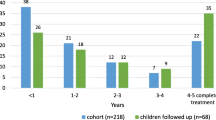Abstract
Both private and socialized healthcare systems require treatments to be not only effective, but also cost-efficient. Although the Ponseti method of clubfoot treatment is effective, its cost-effectiveness has not been demonstrated. We compared the difference in resource use between two prospective cohorts treated for clubfoot by either the Ponseti method or below-knee casting followed by primary surgical release in the socialized healthcare system of New Zealand. Using these cohorts and US billing data, costs of treating these cohorts in the US healthcare system were also calculated. Treatment of initial deformity, recurrences, and complications in both cohorts were included in the final assessment. Twenty-six patients (40 feet) were enrolled in the Ponseti cohort and 29 (46 feet) in the primary surgical cohort. For most patients, the Ponseti method was more cost-effective than the primary surgical treatment in both healthcare systems. The cost of treating both cohorts was lower in the socialized system than in the US healthcare system.
Level of Evidence: Level II, prognostic study. See the Guidelines for Authors for a complete description of levels of evidence.
Similar content being viewed by others
References
Beals RK. Club foot in the Maori: a genetic study of 50 kindreds. N Z Med J. 1978;88:144–146.
Colburn M, Williams M. Evaluation of the treatment of idiopathic clubfoot by using the Ponseti method. J Foot Ankle Surg. 2003;42:259–267.
Cooper DM, Dietz FR. Treatment of idiopathic clubfoot. A thirty-year follow-up note. J Bone Joint Surg Am. 1995;77:1477–1489.
Cosma D, Vasilescu D, Vasilescu D, Valeanu M. Comparative results of the conservative treatment in clubfoot by two different protocols. J Pediatr Orthop B. 2007;16:317–321.
Crawford AH, Marxen JL, Osterfeld DL. The Cincinnati incision: a comprehensive approach for surgical procedures of the foot and ankle in childhood. J Bone Joint Surg Am. 1982;64:1355–1358.
Dietz FR. Treatment of a recurrent clubfoot deformity after initial correction with the Ponseti technique. Instr Course Lect. 2006;55:625–629.
Dobbs MB, Nunley R, Schoenecker PL. Long-term follow-up of patients with clubfeet treated with extensive soft-tissue release. J Bone Joint Surg Am. 2006;88:986–996.
Dobbs MB, Rudzki JR, Purcell DB, Walton T, Porter KR, Gurnett CA. Factors predictive of outcome after use of the Ponseti method for the treatment of idiopathic clubfeet. J Bone Joint Surg Am. 2004;86:22–27.
Flynn JM, Donohoe M, Mackenzie WG. An independent assessment of two clubfoot-classification systems. J Pediatr Orthop. 1998;18:323–327.
Haft GF, Walker CG, Crawford HA. Early clubfoot recurrence after use of the Ponseti method in a New Zealand population. J Bone Joint Surg Am. 2007;89:487–493.
Heilig MR, Matern RV, Rosenzweig SD, Bennett JT. Current management of idiopathic clubfoot questionnaire: a multicentric study. J Pediatr Orthop. 2003;23:780–787.
Herzenberg JE, Radler C, Bor N. Ponseti versus traditional methods of casting for idiopathic clubfoot. J Pediatr Orthop. 2002;22:517–521.
Ippolito E, Farsetti P, Caterini R, Tudisco C. Long-term comparative results in patients with congenital clubfoot treated with two different protocols. J Bone Joint Surg Am. 2003;85:1286–1294.
Ippolito E, Fraracci L, Caterini R, Di Mario M, Farsetti P. A radiographic comparative study of two series of skeletally mature clubfeet treated by two different protocols. Skeletal Radiol. 2003;32:446–453.
Ippolito E, Mancini F, Di Mario M, Farsetti P. A comparison of resultant subtalar joint pathology with functional results in two groups of clubfoot patients treated with two different protocols. J Pediatr Orthop B. 2005;14:358–361.
Laaveg SJ, Ponseti IV. Long-term results of treatment of congenital club foot. J Bone Joint Surg Am. 1980;62:23–31.
Morcuende JA, Dolan LA, Dietz FR, Ponseti IV. Radical reduction in the rate of extensive corrective surgery for clubfoot using the Ponseti method. Pediatrics. 2004;113:376–380.
New Zealand Government. Statistics in New Zealand. Ethnic group for the census usually resident population count 2001. Available at: www.stats.govt.nz. Accessed November 3, 2006.
Ponseti IV. Treatment of congenital club foot. J Bone Joint Surg Am. 1992;74:448–454.
Ponseti IV. The ponseti technique for correction of congenital clubfoot. J Bone Joint Surg Am. 2002;84:1889–1890.
Tindall AJ, Steinlechner CW, Lavy CB, Mannion S, Mkandawire N. Results of manipulation of idiopathic clubfoot deformity in Malawi by orthopaedic clinical officers using the Ponseti method: a realistic alternative for the developing world? J Pediatr Orthop. 2005;25:627–629.
Acknowledgments
We thank Jan E. Davison, the clubfoot nurse specialist at Starship Children’s Health Auckland, New Zealand, for her time and effort in caring for these children. In addition, we thank Jan for her help in preparing the manuscript.
Author information
Authors and Affiliations
Corresponding author
Additional information
Each author certifies that he or she has no commercial associations (eg, consultancies, stock ownership, equity interest, patent/licensing arrangements, etc) that might pose a conflict of interest in connection with the submitted article.
Each author certifies that his or her institution has approved or waived approval for the human protocol for this investigation and that all investigations were conducted in conformity with ethical principles of research.
An erratum to this article can be found at http://dx.doi.org/10.1007/s11999-010-1234-7
Appendix 1
Appendix 1

About this article
Cite this article
Halanski, M.A., Huang, JC., Walsh, S.J. et al. Resource Utilization in Clubfoot Management. Clin Orthop Relat Res 467, 1171–1179 (2009). https://doi.org/10.1007/s11999-008-0674-9
Received:
Accepted:
Published:
Issue Date:
DOI: https://doi.org/10.1007/s11999-008-0674-9




